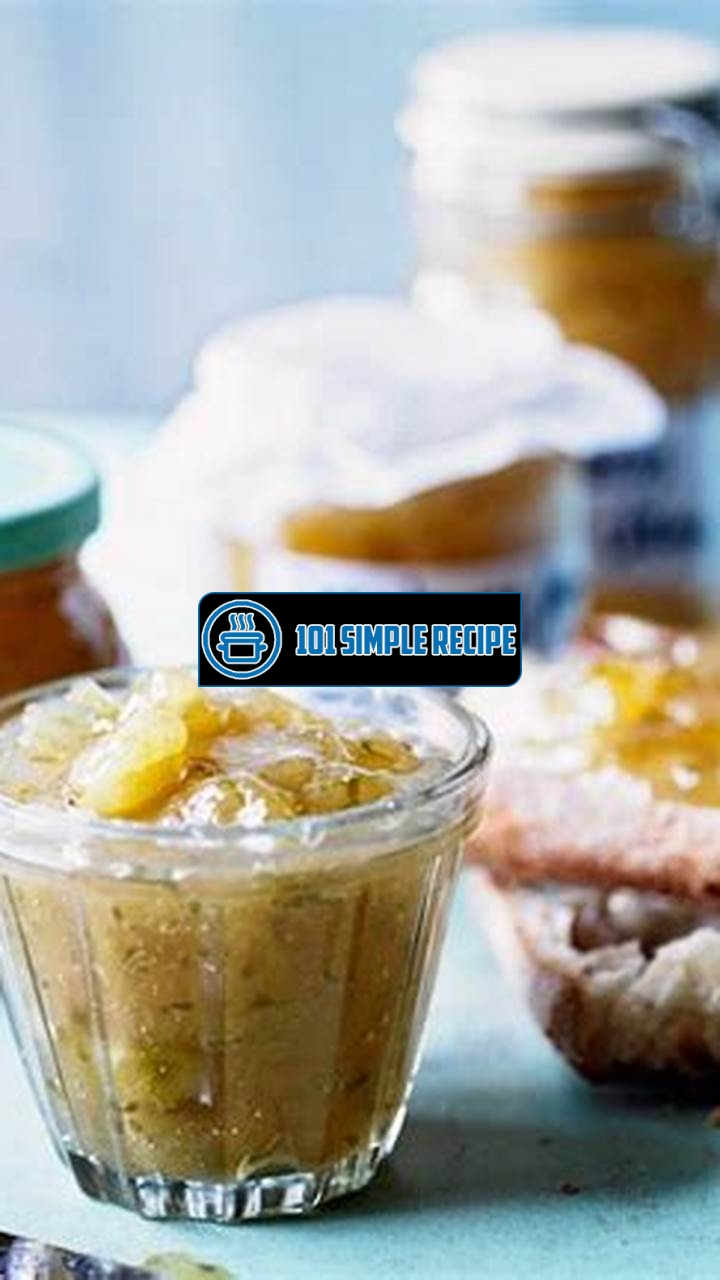Get ready to tantalize your taste buds with a summer delight: the mouthwatering Delicious Gooseberry and Elderflower Jam! This delectable jam is the perfect blend of tart gooseberries and fragrant elderflowers, creating a symphony of flavors that will transport you to a sun-soaked orchard. Whether you spread it on warm toast, drizzle it over pancakes, or use it as a filling for pastries, this jam is sure to become your favorite summer indulgence. So, grab a jar and savor the taste of this homemade treat that captures the essence of the season.

Getting Started with Gooseberry and Elderflower Jam
Discover the delightful combination of gooseberries and elderflower in a homemade jam. This delicious recipe brings together the sweet and tangy flavors of gooseberries with the delicate floral notes of elderflower. Whether you are a jam enthusiast or a newcomer to preserving, this gooseberry and elderflower jam is a must-try for all.
The Origins of Gooseberry and Elderflower Jam
The origins of gooseberry and elderflower jam can be traced back to traditional English and European cuisines. Gooseberries have been grown and enjoyed for centuries and are commonly used in various culinary preparations, including jams, pies, and desserts. Elderflower, on the other hand, is the delicate and fragrant blossom of the elder tree, often used in infusions and syrups. The combination of these two ingredients creates a unique and delightful flavor profile that is loved by many.
Note: Gooseberry and elderflower jam has a long history and is deeply rooted in traditional culinary practices.
Health Benefits of Gooseberries and Elderflower
Aside from their delicious taste, gooseberries and elderflowers also offer a range of health benefits. Gooseberries are packed with vitamins and minerals, including vitamin C, vitamin A, and potassium. They are also a great source of antioxidants, which help protect the body against free radicals and oxidative stress.
Elderflower, on the other hand, is known for its immune-boosting properties. It is rich in antioxidants, flavonoids, and phenolic compounds that may help strengthen the immune system and reduce inflammation. Additionally, elderflower has been used in traditional medicine to relieve symptoms of colds, flu, and allergies.
Note: Gooseberries and elderflowers are not only delicious but also offer a range of health benefits.
Why Make Gooseberry and Elderflower Jam at Home?
While you can easily find store-bought jams, making your own gooseberry and elderflower jam at home offers several advantages. Firstly, homemade jams allow you to control the quality of ingredients. You can choose organic, locally sourced berries and flowers, ensuring that your jam is free from artificial additives and preservatives.
Secondly, homemade jams give you the freedom to customize the flavors according to your preference. You can experiment with different ratios of gooseberries and elderflowers to achieve the perfect balance of sweetness and floral essence. You can also adjust the sweetness level by adding natural sweeteners like honey or maple syrup.
Lastly, making gooseberry and elderflower jam at home is a rewarding culinary experience. It allows you to connect with traditional recipes and indulge in the joy of preserving seasonal produce. The process of making jam is also a great way to relax and unwind, as you immerse yourself in the aromas and tastes of fresh ingredients.
Note: Making gooseberry and elderflower jam at home gives you control over the ingredients, allows customization of flavors, and provides a rewarding culinary experience.
Gathering the Ingredients and Equipment
To create a flavorsome batch of gooseberry and elderflower jam, it’s crucial to gather the right ingredients and equipment. Let’s delve into what you’ll need for this delightful summer recipe.
Fresh vs. Frozen Gooseberries
When it comes to selecting gooseberries for your jam, you have the choice between using fresh or frozen ones. Both options have their merits, so it ultimately depends on your preference and availability.
If you have access to fresh gooseberries, they will undoubtedly bring a vibrant and tangy flavor to your jam. These plump, juicy fruits are usually available during the summer months, making them a perfect fit for this seasonal delight. Remember to wash and top-and-tail the fresh gooseberries before use.
On the other hand, if fresh gooseberries aren’t easily obtainable, frozen ones are a convenient alternative. Frozen gooseberries are often picked and flash-frozen at their peak ripeness, ensuring that their flavor and nutrients are preserved. Simply thaw the frozen berries and drain any excess liquid before incorporating them into your jam.
Sourcing Elderflower
The delicate floral essence of elderflower adds a unique touch to gooseberry jam. Sourcing fresh elderflowers might require some effort, but the flavor they provide is worth it.
If you have access to an elderflower bush, you can pick the blossoms yourself. Look for elderflower clusters with creamy white flowers that are in full bloom. Be sure to avoid any brown or withered blossoms, as they won’t contribute the desired flavor. Gently shake the blossoms to remove any insects before using them in your recipe. A general guideline is to use about 10 to 15 elderflower heads for every 1 kilogram (2.2 pounds) of gooseberries.
If you’re unable to forage for fresh elderflowers, you can explore alternative options. Some grocery stores or specialty food shops may offer dried elderflowers or elderflower cordial as a substitute. While these options may not provide the same freshness as fresh blossoms, they can still infuse your jam with a delightful elderflower essence.
Essential Equipment for Jam Making
Now, let’s turn our attention to the essential equipment needed for making gooseberry and elderflower jam. Having the right tools will ensure a smooth and successful jam-making process.
– Large stainless steel or enamel saucepan: This will serve as the primary vessel for cooking your jam mixture. Choose a saucepan with a capacity of at least 6 liters (1.5 gallons) to accommodate the boiling jam without any overflow.
– Jam thermometer: A reliable jam thermometer is essential for attaining the perfect consistency and ensuring your jam sets properly. Look for a thermometer that measures temperatures up to 220°C (428°F).
– Muslin or cheesecloth: You will need these materials to create a bouquet garni, which is a bundle of herbs and spices tied together. The bouquet garni allows the flavors of the elderflower to infuse into the jam while keeping the blossoms contained and easily removable.
– Jam jars and lids: Prepare enough clean, sterilized jam jars and their corresponding lids for storing your finished product. It’s best to use jars specifically designed for canning or preserving.
– Funnel: A funnel will simplify the process of transferring the hot jam into the jars, minimizing the risk of spills and burns.
By gathering these ingredients and ensuring you have the necessary equipment, you’ll be well-prepared to embark on your gooseberry and elderflower jam-making adventure. Get ready to savor the delightful flavors of summer encapsulated in a jar that’s bound to impress!
Preparing the Gooseberries and Elderflower
In order to create a delicious gooseberry and elderflower jam, it is essential to properly prepare and handle the ingredients. This involves removing the stems and blossom ends from the gooseberries, as well as trimming and cleaning the elderflower. Additionally, there are some important tips to keep in mind when handling these ingredients.
Removing Stems and Blossom Ends
Before you begin the jam-making process, it’s necessary to remove the stems and blossom ends from the gooseberries. This can be done by gently holding the gooseberry between your thumb and index finger and pulling off the stem. Remove any blossom ends as well, as they can have a bitter taste.
It is important to handle the gooseberries with care to avoid damaging them and to ensure an optimal taste in the final product. Be gentle when removing the stems and blossom ends, as applying too much pressure can cause the gooseberries to become mushy. Remember, you want the gooseberries to retain their shape and texture in the jam.
Trimming and Cleaning Elderflower
When using elderflower in your jam recipe, it is crucial to properly trim and clean the flower heads. Start by trimming off any excess stems or leaves attached to the flower heads. Then, rinse the flower heads under cold running water to remove any dirt or debris.
Elderflower has a delicate flavor that can greatly enhance the taste of the jam. However, it is important to handle the flower heads with care to prevent them from becoming damaged. Gently trim and clean each flower head to preserve its flavor and integrity in the jam.
Important Tips for Handling Ingredients
Here are some important tips for handling the gooseberries and elderflower:
- Always use fresh and ripe gooseberries for the best flavor. Overripe or underripe gooseberries may affect the taste and texture of the jam.
- Ensure that the elderflower used is completely free of insects or bugs. Remove any unwanted visitors before incorporating the flower heads into the jam.
- Use a sharp knife or kitchen shears to trim the elderflower. This will make the process easier and prevent any damage to the flower heads.
- Store the gooseberries and elderflower in separate containers until you’re ready to use them. This will help maintain their freshness and prevent cross-contamination.
- Handle the ingredients gently to avoid bruising or crushing them. This will ensure that the jam has a pleasant texture and appearance.
Remember, the quality of the ingredients and the care taken in their preparation can greatly impact the final taste and quality of the gooseberry and elderflower jam.
By following these tips and properly preparing the gooseberries and elderflower, you’ll be well on your way to creating a delightful summer jam that will be enjoyed by all!
The Jam-Making Process
Discover the step-by-step process of turning gooseberries and elderflower into a delicious jam. Making homemade jam is a wonderful way to preserve the flavors of summer, and the combination of gooseberries and elderflower creates a truly delightful spread that can be enjoyed all year round.
Cooking the Fruit and Flowers
To begin the jam-making process, you’ll need fresh gooseberries and elderflower. Start by thoroughly washing the gooseberries and removing any stems or leaves. Once cleaned, place the gooseberries in a large pot with the elderflower heads. These delicate blooms add a floral note to the jam and enhance its flavor.
Next, add enough water to the pot to cover the fruit and flowers. It’s important to use a gentle heat to slowly simmer the mixture. This will allow the flavors to infuse and develop. As the fruit cooks, it will soften and release its natural juices.
Pro Tip: Use a wooden spoon to gently stir the mixture as it cooks. This will prevent the fruit from sticking to the bottom of the pot.
Adding Sugar and Acid
Once the fruit and flowers have cooked down and become soft, it’s time to add the sugar and acid. Sugar acts as a preservative, helping to extend the shelf life of the jam, while acid adds a tangy note and helps the jam set properly.
For every pound of gooseberries and elderflower, you’ll need to add an equal amount of granulated sugar. This creates a balanced sweetness that enhances the natural flavors of the fruit. Additionally, adding a splash of lemon juice or citric acid helps to ensure a good set and contributes to the overall taste of the jam.
✨ Fun Fact: Gooseberries are naturally high in pectin, a natural thickening agent found in many fruits. This means that gooseberry and elderflower jam will naturally set without the need for additional pectin.
The Role of Pectin in Jam Making
Pectin is a crucial component in jam making as it helps the mixture thicken and set properly. Gooseberries, along with other fruits such as apples and citrus fruits, contain high levels of pectin naturally. This means that when combined with sugar and cooked down, the mixture will naturally reach the desired consistency.
However, if you prefer a firmer set or your gooseberries aren’t particularly ripe, you can add additional pectin in the form of a commercial pectin product. These are readily available in most supermarkets and come with detailed instructions on how to use them.
Handy Tip: To test if your jam has reached the desired consistency, place a small amount on a chilled plate and allow it to cool. If it forms a gel-like texture and wrinkles when pushed with your finger, it’s ready to be canned.
With these simple steps, you can create a delicious gooseberry and elderflower jam that captures the essence of summer. Spread it on toast, scones, or use it as a filling for pastries to enjoy the taste of summer all year long!
Jarring and Preserving the Jam
In this section, you will learn all about jarring and preserving your delicious gooseberry and elderflower jam. By following these steps, you can enjoy your homemade jam for a long time to come. Let’s get started!
Preparing Jars and Lids
Before you begin the jarring process, it’s important to prepare your jars and lids properly. This ensures that your jam stays fresh and free from any contaminants. Here’s what you need to do:
- Wash and sterilize: Start by washing your jars and lids thoroughly with hot soapy water. Rinse them well and place them in a large pot of boiling water. Let them boil for about 10 minutes to sterilize.
- Keep them warm: Once sterilized, remove the jars and lids from the boiling water using tongs. Place them on a clean towel to cool slightly and keep them warm until you’re ready to fill them with your jam.
Note: It’s essential to sterilize the jars and lids to prevent any bacteria from contaminating your delicious homemade jam. This step ensures your jam stays safe to eat for a longer period.
The Water Bath Method
The water bath method is a popular way to preserve jams and jellies, including your gooseberry and elderflower jam. Follow these steps to use the water bath method:
- Fill the pot: Start by filling a large pot with water and placing it on the stove over high heat. Bring the water to a boil.
- Prepare the jam: While the water is heating, prepare your gooseberry and elderflower jam according to your recipe. Make sure it reaches the desired consistency before jarring.
- Fill the jars: Carefully fill the warm, sterilized jars with hot jam, leaving about ¼ inch of headspace at the top. Wipe any spills or drips from the jar rims.
- Seal the jars: Place the lids on the jars and tighten them securely. Make sure they are not too tight to prevent air from escaping during the water bath process.
- Process the jars: Using jar tongs, carefully lower the filled jars into the pot of boiling water, ensuring they are fully submerged. Let them process for about 10-15 minutes.
- Remove and cool: After the processing time is complete, carefully remove the jars from the water bath using jar tongs. Place them on a towel-lined countertop and let them cool completely.
With the water bath method, your gooseberry and elderflower jam will be safely preserved, sealed, and ready to enjoy.
Storing and Enjoying Your Homemade Jam
Now that your delicious gooseberry and elderflower jam is properly jarred and preserved, you must store it correctly to maintain its flavor and quality. Here are some tips:
- Cool and check: Allow your jars of jam to cool completely before storing them. Check the lids to ensure they have sealed properly by pressing down on the center of each lid. If it pops back, it hasn’t sealed correctly, and you should refrigerate and consume that jar first.
- Store in a cool, dark place: Find a cool, dark spot in your pantry or cupboard to store your jars of jam. Avoid direct sunlight, as it can cause the jam to spoil or change in flavor.
- Label and date: It’s a good practice to label each jar with the date it was made. This helps you keep track of the freshness and allows you to use the oldest jars first.
- Enjoy within a year: For the best flavor and quality, consume your homemade gooseberry and elderflower jam within a year. Although it may last longer, the flavor may diminish over time.
By properly storing your jam, you can enjoy its sweet and tangy taste throughout the year. Spread it on toast, use it in desserts, or share it with friends and family for a delightful summer treat!
Thank you for reading our delicious recipe for gooseberry and elderflower jam! We hope you found this article helpful and inspiring. Don’t forget to come back later for more mouthwatering recipes and cooking tips. Stay tuned and happy jam-making!
Frequently Asked Questions
Here are some frequently asked questions about gooseberry and elderflower jam:
| No. | Questions | Answers |
|---|---|---|
| 1 | Can I use frozen gooseberries for this recipe? | Yes, you can use frozen gooseberries. Just make sure to thaw them before cooking. |
| 2 | Can I substitute elderflower cordial with fresh elderflowers? | Yes, you can use fresh elderflowers instead of cordial. Just make sure to adjust the quantity according to taste. |
| 3 | How long can I store the jam? | Properly sealed and stored, the jam can last up to a year. Once opened, refrigerate and consume within a month. |
| 4 | Can I reduce the amount of sugar in the recipe? | Yes, you can reduce the sugar, but it may affect the texture and shelf life of the jam. |
| 5 | What can I use gooseberry and elderflower jam for? | The jam is perfect for spreading on toast, scones, or even as a filling for pastries and cakes. |
| 6 | Can I use this recipe for other fruits? | Yes, you can adapt this recipe for other fruits, such as strawberries or blackberries. |
Happy Jam-making!
We hope you enjoy making and savoring the delicious gooseberry and elderflower jam. Remember, homemade jams are always a delightful treat. So gather your ingredients and get ready to wow your taste buds with this flavorful concoction. Don’t forget to share your jam adventures with us and come back soon for more exciting recipes!
Jump to Recipe
Gooseberry and Elderflower Jam Recipe

Learn how to make delicious gooseberry and elderflower jam with this easy recipe. Perfect for spreading on toast or using as a filling for pastries and cakes.
- 500 g gooseberries
- 400 g sugar
- 100 ml elderflower cordial
- 1 lemon (juice and zest)
- Wash and remove the stems from the gooseberries. Zest and juice the lemon.
- In a large pot, combine the gooseberries, sugar, elderflower cordial, lemon juice, and zest. Cook over medium heat, stirring frequently, until the sugar has dissolved. Increase the heat and bring the mixture to a boil. Continue boiling for 20-25 minutes, or until the jam reaches the desired consistency. Skim off any foam that forms on the surface.
- While the jam is cooking, sterilize the jars and lids by washing them in hot soapy water, rinsing well, and placing them in a 200°F (93°C) oven for 10 minutes.
- Carefully remove the jars from the oven and fill them with the hot jam, leaving a 1/4-inch (0.6 cm) headspace. Wipe the rims of the jars with a clean, damp cloth, and seal them tightly with the sterilized lids and rings.
- Place the filled jars in a canning pot or large stockpot filled with simmering water. Ensure the jars are fully submerged and bring the water to a gentle boil. Process for 10 minutes. Remove the jars from the water bath and let them cool completely before storing.






